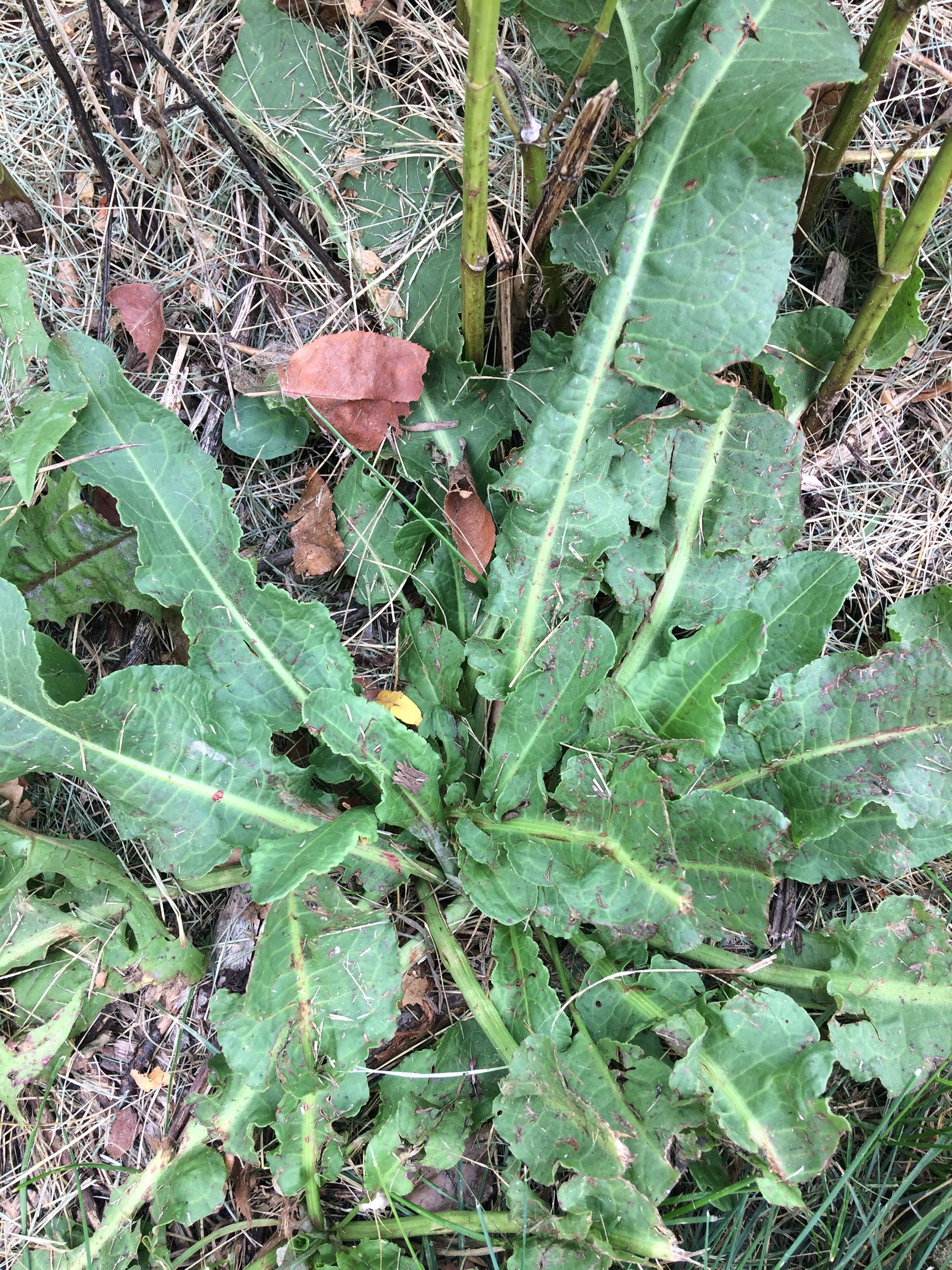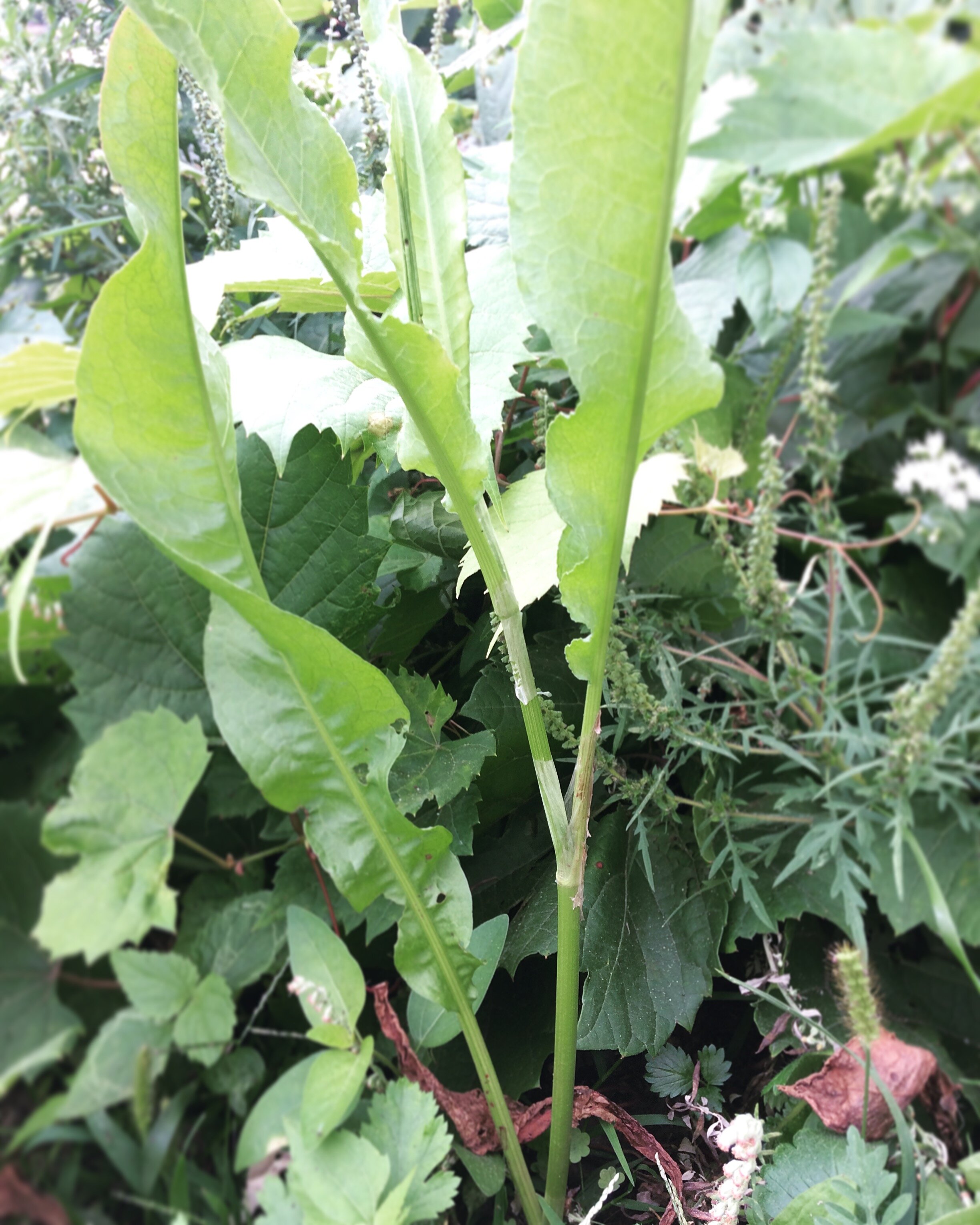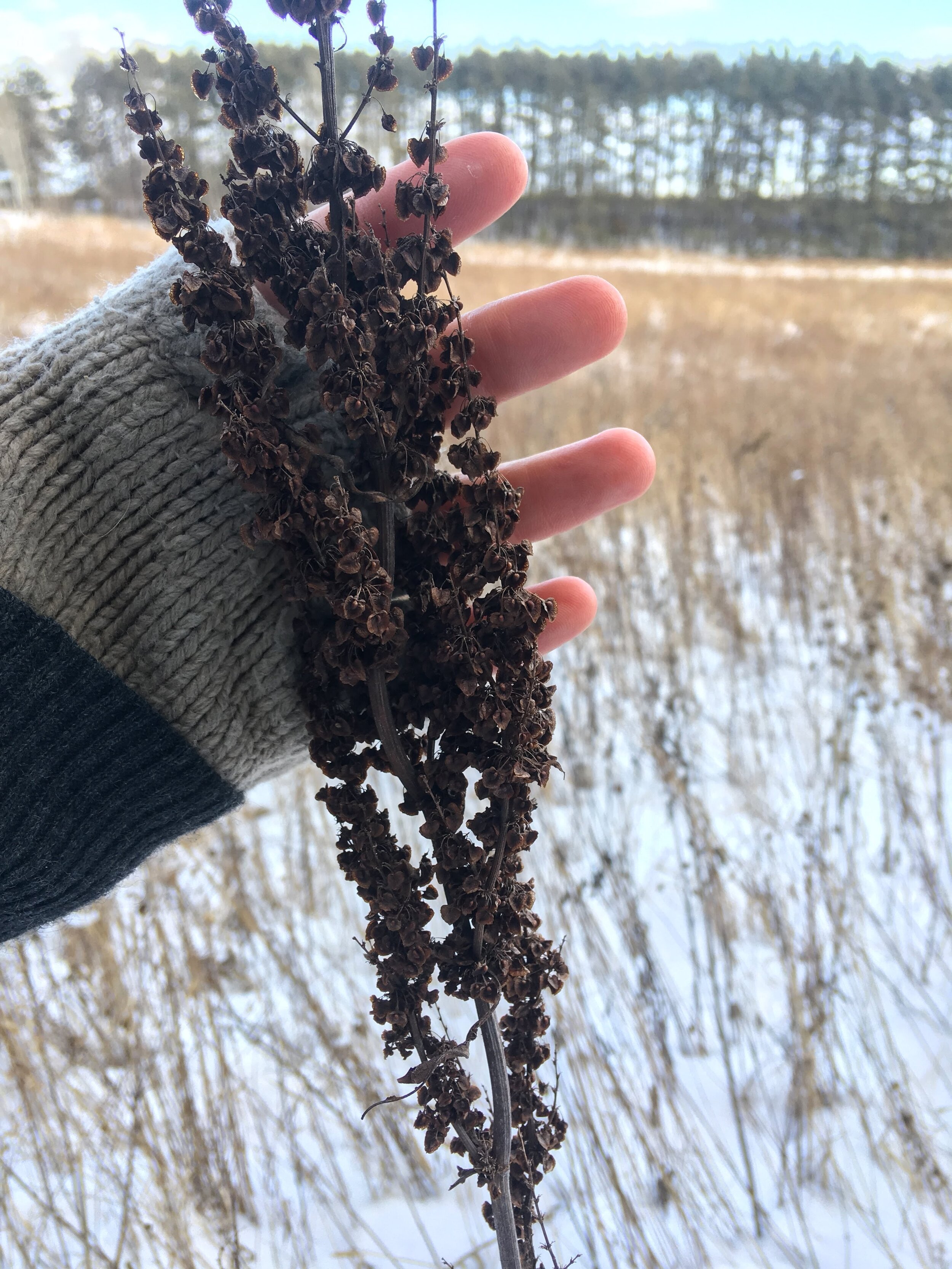Curly Dock: A Plant for Year-Round Sustenance
Prefer to listen to this article? No problem! Four Season Foraging now offers free audio versions of articles with the help of a text-to-speech website. Simply click the play button on the right!
Curly dock plants displaying their voluminous seedheads.
Curly dock (Rumex crispus, also called yellow dock) is one of those plants that is easily overlooked. It doesn’t have a showy flower and the leaves can look kind of generic. Furthermore, it’s not typically as prolific of a weed as dandelion— at least not in urban areas. It’s unfortunate that people aren’t more familiar with it, as the leaves, stem, seed, and root are all edible or medicinal. And with its wide distribution, it’s easy to start eating!
Habitat and Distribution
Curly dock isn’t too discerning about its habitat, growing in full sun and part shade, fields, roadsides, trailsides, and other open areas. Native to Europe, it has been introduced to all fifty states in the US and all Canadian provinces except Nunavut.
Identification




The leaves of curly dock are hairless, long and narrow, and often have wavy or curly edges—which is where it gets its common name. The plant has both basal leaves and leaves on the stem, which are alternate. Basal leaves can be as long as 12 inches and around 2 ½ inches wide; the leaves become smaller as they ascend the stem. A thin whitish sheath grows around the node (where the petiole and stalk meet.) This sheath become brown and papery with time, and eventually disintegrates. The main stem is ribbed, stout, and mostly unbranched. The plant can reach heights of one to five feet at maturity.
Flowers grow in branching clusters at the top of the plant, in groups of 10 to 25. Despite this large quantity, they are rather inconspicuous because they are small and greenish (though they can also be yellowish or pinkish.) They appear in whorls, meaning that they grow all the way around a single point on the stem.
Seeds appear in late summer and fall. They are three-sided, oval to egg-shaped, with a sharp point on one end. The seeds are encased in a leaf-like capsule that turns brown and papery with age. These seeds are the best way to identify curly dock in winter, as they often remain on the dead stalk until spring. (See below for close-up pictures of the seeds.) If you are unfamiliar with curly dock, I don’t recommend immediately picking a dead winter stalk for the seeds. Instead, practice positively identifying the plant during the growing season. Then observe the plant as it ages through the fall and winter, and then start picking the dead winter stalks. I believe that this is best way to learn to identify plants in winter.
Similar Species
Broad-leaved dock (Rumex obtusifolius)
Many species of dock (Rumex spp.) grow in the United States and Canada. Besides curly dock, broad-leaved dock (Rumex obtusifolius) is the main species that’s eaten. This dock has large, broad heart-shaped leaves, unlike the long, narrow leaves of curly dock. The leaves, stem, and seeds of broad-leaved dock can be eaten like those of curly dock, but the root does not have the same medicinal qualities. Broad-leaved dock can be found in all 50 US states except Nevada, Wyoming, and North Dakota. In Canada, it grows in Quebec, Ontario, and British Columbia.
Western dock (R. occidentalis), dooryard dock (R. longifolius), field dock (R. stenphyllus), wild rhubarb (R. hymenosepalus) and patience dock (R. patientia) are all edible as well. As far as I know, there are no poisonous species of dock, though some are considered inedible due to unpalatability.
Harvest and Preparation
The creases along this dock leaf is a sign that it unfurled recently and is therefore likely tender and delicious.
Leaves and Stem
Start looking for dock leaves in early spring. Typically the sooner you get them, the more sweet and tender they are, but this depends on growing conditions. I used to hate dock, and could not for the life of me understand how people could compare it to spinach. Then I found a beautiful stand of it growing in an open pine forest. The leaves were large, light green, and supple; and they tasted just like spinach! No, better, even—the sour, lemony aspect was much more pronounced. I didn’t like all the previous dock leaves I had eaten because they were stressed out and stunted from growing in poor, gravelly soils. This is why with foraging it’s important to try species from varying locations!
Regardless, dock leaves can be eaten raw or cooked. When the plant sends up a stem, the basal leaves generally become too tough and bitter to eat, but those on the stem may be palatable. However, the best portion is the stem itself! Harvest dock stems in late spring and early summer, before it reaches full height and any flowers appear. It should feel supple and bendy; if not, it’s probably too tough to eat. The outer layer may be stringy, but this can be peeled before eating. If it’s tender enough, eat it raw; otherwise it’s delicious steamed or sautéed. You could even pickle it! The flavor is similar to the leaves, except more “green” tasting—something like green beans.
Dock leaves and stems contain oxalic acid, which is what gives them their yummy sour flavor. However, this does require a note of caution, as oxalic acid prevents the assimilation of minerals such as calcium and iron. But this compound is also found in many cultivated plants, including rhubarb, spinach, and Swiss chard. While one often reads warnings about oxalic acid in wild food literature, one rarely hears warnings about eating those domesticated foods. I believe that this is due to an unfair bias against wild foods. As long as you're not severely mineral deficient, and as long as you're not consuming unreasonably massive amounts of foods containing oxalic acid, you'll be fine!
Corpsmember with curly dock removed from the Ag Heritage Center. (photo credit: Boulder County Youth Corps / CC BY 2.0)
Roots
Curly dock is a perennial, meaning that the same plant returns year after year. The best time to harvest the roots is after it’s grown in size, which means waiting at least until the fall of its first year. The root can be dug throughout winter if weather allows. Where I live in Minneapolis, the ground freezes in winter, which makes it impossible to harvest roots at that time. If you live in a warmer climate you can probably dig curly dock roots throughout winter. Otherwise you can harvest the root in the spring of its second year, or any year thereafter. It’s best not to harvest roots when the plant has a living stalk (a dead winter stalk is fine), because that means that the plant is depleting energy from the root to make flowers and reproduce. Energy equals starch, which is the tasty part of the root that we humans like to consume! So spring and fall are the best times to harvest roots, because that’s when the plant is putting energy (i.e. starch) into the root instead of taking it away.
The root of curly dock can grow quite large, so it’s easiest to harvest by digging alongside the root with a shovel or trowel, rather than attempting to pry it out of the ground. It is generally too bitter to be considered edible, though it does have some useful medicinal qualities, which are outlined below.
Harvested seeds of curly dock.
Seeds
As a relative of buckwheat, dock seeds are edible as well! Some people say they’re not worth harvesting because so much processing is required to separate the seed from the chaff. However, you can just grind the seed and chaff all together as one. It’s just extra fiber and won’t hurt you. Seeds appear in late summer, and should be harvested when they’re brown, dry, and papery. They often remain on the plant throughout winter.
The seeds grow in massive quantities on the stem and are quite easy to collect. Simply pick the entire stem using a knife or clippers. Then strip the seeds from the stem over a paper bag or large bowl. You’ll have a large amount in no time! Sift the seeds through a sieve or colander to remove any bugs or debris. Then grind them in a grain grinder, coffee grinder, mortar and pestle, or blender to make flour. Store in an airtight container. Since the flour doesn’t have gluten and contains a high amount of fiber, it’s easier to work with if mixed with wheat flour.
Crackers made with curly dock seeds.
Recipe: Curly Dock Crackers
From http://www.ediblewildfood.com/yellow-dock-crackers.aspx
These crackers have a wonderfully earthy flavor. I think they combine well with something tart, like pickles, rhubarb preserves, or chutney. Serves 4 to 6.
Ingredients
1 cup ground curly dock seed
1 cup flour of your choice (I use all-purpose wheat flour)
1 tsp. sea salt
Water
Instructions
In a bowl mix together the ground yellow dock seed, flour, and salt. Add in water very slowly until the dough is pliable (not sticky).
On a well-floured surface roll dough thinly. Cut into desired shapes. Then transfer them onto a well-greased baking sheet.
Bake 10 to 12 minutes at 375°F or until crisp.
Medicinal Properties
Curly dock gets its other common name (yellow dock) from its yellow root, which gets its color from the compound anthraquinone. This compound has a laxative effect, making yellow dock root an excellent remedy for constipation. Furthermore, it stimulates the flow of bile, which aids digestion. It also soothes the intestinal lining, making it useful against irritable bowels.
The root also has a diuretic effect, meaning that it stimulates urination. This can help with bloating, urinary tract infections, and urinary stones, especially when taking into account yellow dock’s soothing effect.
As a cooling and healing root, it has been used to treat several kinds of inflammatory skin conditions, such as eczema, psoriasis, and nettle rash. It is also useful against internal inflammation, such as arthritis and rheumatism.
Decoction
Yellow dock root should be made into a decoction, in which the plant matter is boiled, instead of an infusion, in which the plant matter is steeped in hot water. Decoctions are used for tough, woody material such as roots, bark, and twigs, in order to extract the active constituents. Infusions are used for herbs with delicate aromatic principles that require more careful preparation. To make a decoction, start with ½ cup finely chopped fresh root. (Make sure you scrub the root clean first!) If using dried root, you will need less: only about ⅓ of the original amount, or about 3 tablespoons in this instance. Put the chopped root in a non-reactive pot, such as stainless steel or glass. Add 3 cups cold water. Bring to a boil, and simmer uncovered about 20 minutes, or until the liquid is reduced by approximately ⅓ (to 2 cups). Strain the liquid into a mug or jar and discard the plant material. The decoction can be drank hot or cold, and can be stored in the fridge for up to 48 hours. The standard dosage is one cup 3 times a day, though this varies depending on the person and the condition.
Mark the Location
Keep an eye out for this ordinary plant, and soon you will be able to pick it out of the landscape! The easiest time of year to notice it is in summer, fall, and often in the winter, when you can easily observe the multitudinous seeds. Then keep the spot in mind for some yummy greens the following spring, and dig in!
Join Us on Patreon!
This blog post was chosen in a poll by Patreon members. Thank you for your support!
If you like our foraging tutorials, please consider joining us on Patreon! It’s a simple way for you to help Four Season Foraging keep producing the informative content that you enjoy.






